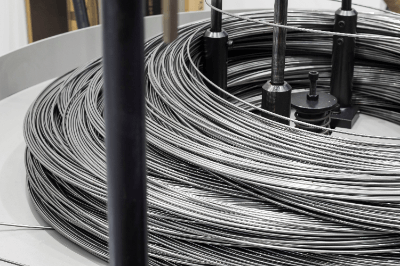What Is a Wire Rod?

Wire rods are coiled wire-like metal materials.
There are two types of wire rods: hot-rolled (as-rolled) and steel wire (wire). Rods are classified as soft wire rods, high carbon wire rods, piano wire, welding rod core wire, cold forging wire rods, and stainless steel wire rods.
By rolling using multiple hot rolling mills, steel billets are processed into smaller diameters ranging from 5 to 20 mm. Wire drawing is used to further reduce the diameter. Annealing (heat treatment) and pickling (descaling and lubrication) are often performed before wire drawing.
Usage of Wire Rods
1. Ordinary Steel Wire Rods
Wire rods are mainly used for products that do not require much strength, such as wires, nails, wire mesh, and screws. They are also useful as wire netting material for fixing fish reef stones, fixing tetrapods on embankments, and fixing rocks on cliff slopes.
2. Special Wire Rods
Used for steel cables requiring high toughness and durability, steel stranded wires, wire spring materials, and tire core materials called steel cords. Wire rods are also useful for covered arc welding rods and core wires for welding, as well as for structural members used in construction, such as poles and piles (main and auxiliary bars).
Features of Wire Rods
Wire rods are characterized by their electrical conductivity, tensile strength, flexibility, corrosion resistance, temperature resistance, electromagnetic shielding, and plasticity. These characteristics indicate their adaptability to electrical signal transmission, mechanical requirements, and environmental conditions.
For example, highly conductive materials such as copper and aluminum are suitable for powering electrical cables and equipment. On the other hand, stainless steel is used when corrosion resistance is important, and flexible materials are used when flexibility is required.
Types of Wire Rods
Wire rods are widely used in various industrial fields and there are different types depending on their properties.
1. Mild Steel Wire
Mild steel wire is a type of steel consisting of iron and a certain percentage of carbon. It has a good balance between flexibility and strength, making it suitable for a wide variety of applications. The manufacturing process for mild steel wire involves hot-rolled rolled wire rods that are cooled and then drawn in a wire drawing machine.
Due to its flexibility, mild steel wire is widely used as metal steel and springs. It is also an important material in construction machinery manufacturing and is processed into various shapes and sizes due to its ease of handling and processing. Although inferior to hard steel in terms of strength, it is an indispensable material in situations where its flexibility is required.
Furthermore, it can be used to make bolts, nuts, and nails. Bolts are also useful not only for automotive and mechanical applications but also for anchor bolts for building foundations.
2. Hard Steel Wire
Hard steel wire is a type of steel that has a higher carbon content than mild steel wire. With its unique properties, it is widely used in various industrial fields. The manufacturing process for hard steel wire begins with patterning the iron carbide Fe3C (cementite) metal structure to create a fine, micron-spaced pearlite structure. The wire is then drawn to further reduce the spacing of the pearlite and increase its strength.
Hard steel wire containing 0.65 to 0.95% carbon has increased hardness due to its crystal structure and carbon arrangement, making it capable of withstanding use in special environments and under high loads. This hard steel wire is called a high-carbon rod and is used as the core of concrete structures, suspension ropes for long-span bridges, and steel cords for the rubber interior of tires.
3. Nonferrous Wire Rods
Wire rods made of materials other than steel have a variety of properties. The main types are copper-clad steel wire, copper wire for electrical use, and phosphor bronze wire.
Copper Clad Steel Wire
Copper-clad steel wire (CP wire) is steel wire covered with copper. This construction combines the high conductivity and strength of copper. It is used where high electrical conductivity is required, such as in electrical wiring. It is also flexible and easy to handle.
Copper Wire for Electrical Applications
Electrical copper wire (FR wire) is made from high-purity copper and has very high conductivity and flexibility. Like copper-clad steel wire (CP wire), FR wire is used where high electrical conductivity is required.
Phosphor Bronze Wire
Phosphor bronze wire (PBW) is a steel wire made of an alloy of copper and phosphorus. It has excellent corrosion resistance and is used in humid environments or where it is susceptible to corrosion. It is available in round, square, flat, and knurled wire shapes.
When used with plating, the plating layer is made of tin and various solder compositions with different melting points.
How to Select Wire Rods
When selecting wire rods, various factors should be considered depending on the application and requirements. The following are the main points to consider when selecting wire rods.
1. Conductivity and Electrical Resistance
If conductivity is required, choose a highly conductive material. For example, CP wire or FR wire. The lower the electrical resistance, the smoother the current flows and the higher the efficiency.
2. Strength and Hardness
When strength is required for structures and machine parts, choose hard steel or strong alloys. This makes the material durable and resistant to loads.
3. Flexibility and Pliability
When wire rods are required to be bendable and flexible, mild steel or special alloys should be selected. This is especially important when used as cables or springs.
4. Corrosion Resistance and Adaptability to the Environment
If rods may be subject to moisture or corrosion, it is advisable to choose materials with high corrosion resistance (e.g., stainless steel, and phosphor bronze).